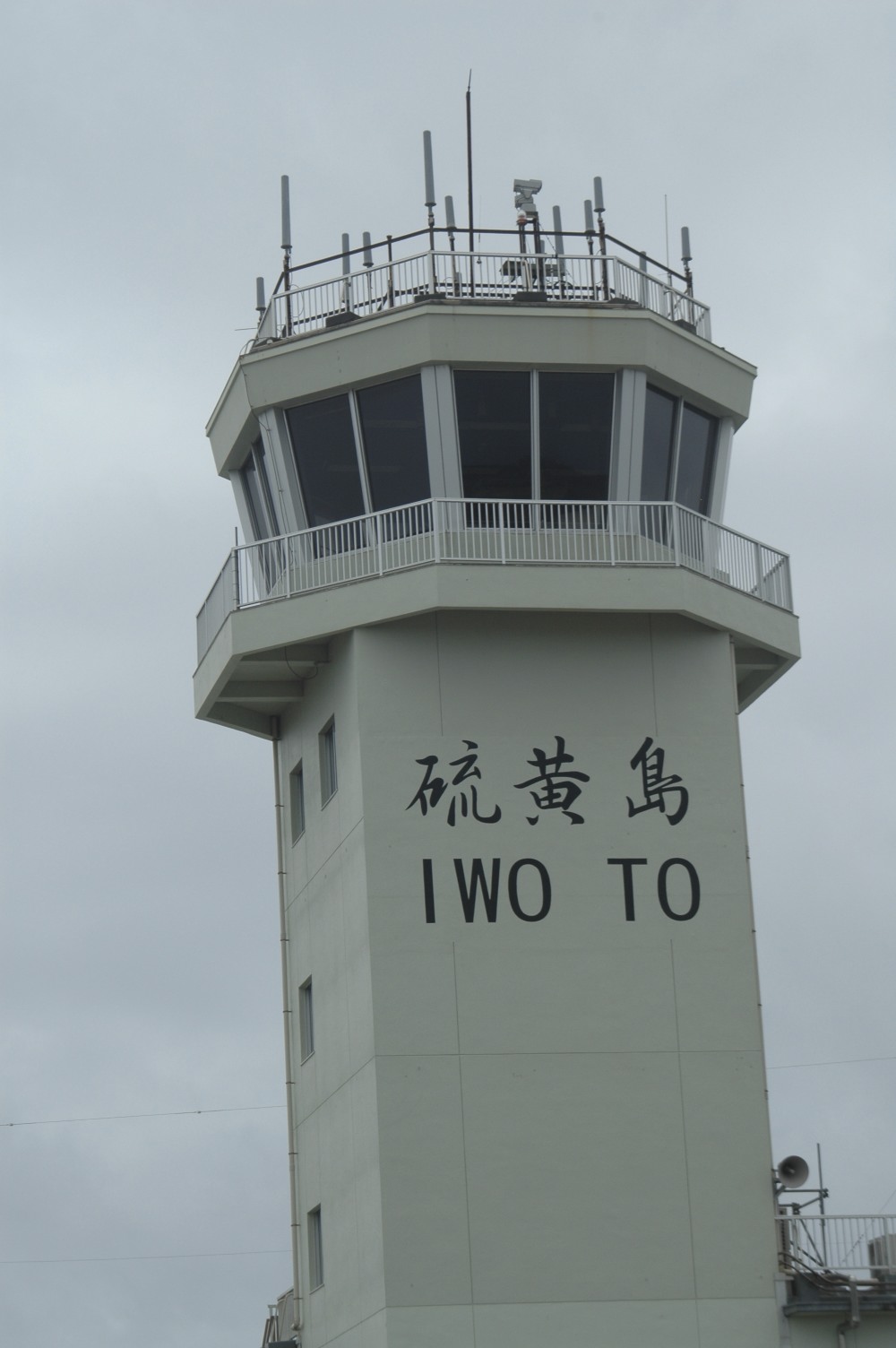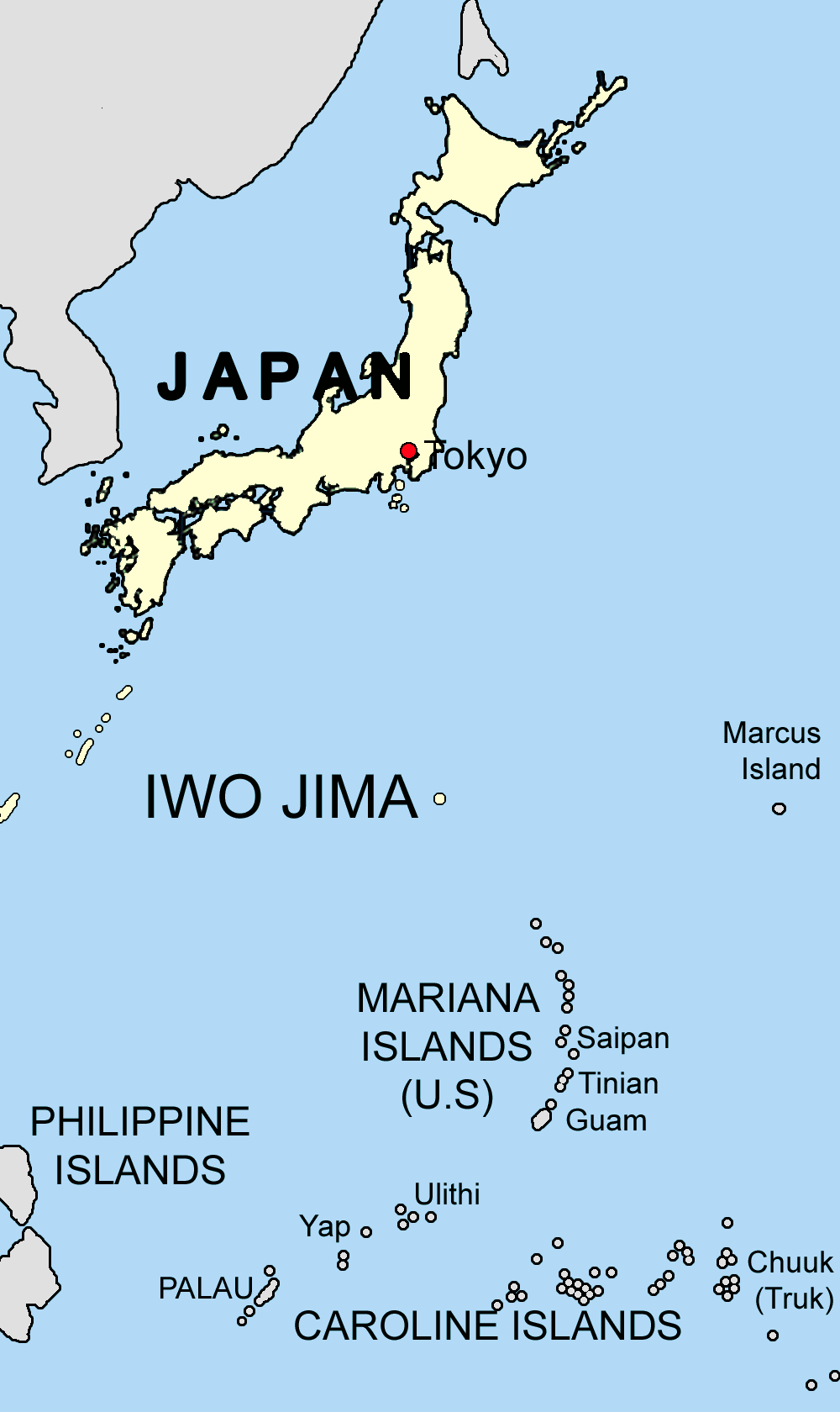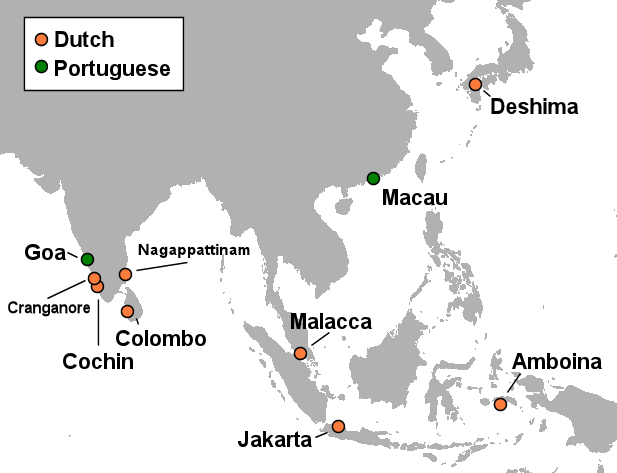|
Iwo Jima
is one of the Japanese Volcano Islands, which lie south of the Bonin Islands and together with them make up the Ogasawara Subprefecture, Ogasawara Archipelago. Together with the Izu Islands, they make up Japan's Nanpō Islands. Although south of Tokyo on Honshu, Iwo Jima is administered as part of the Ogasawara Subprefecture of the Tokyo Metropolitan Government. Only in size, the island is still volcanic island, volcanic and emits sulfurous gases. The highest point of Iwo Jima is Mount Suribachi at high. Although likely passed by Micronesians who made their way to the Bonins to the north, Iwo Jima was largely ignored by the Spanish Empire, Spanish, Dutch Empire, Dutch, British Empire, British, and Empire of Japan, Japanese until a relatively late date after its 1543 rediscovery. The Japanese eventually colonized the island, administering it as the Iojima, Tokyo, Ioto or Iojima Village under Tokyo's jurisdiction until all civilians were forcibly evacuated to Honshu in July 1 ... [...More Info...] [...Related Items...] OR: [Wikipedia] [Google] [Baidu] |
Battle Of Iwo Jima
The was a major battle in which the United States Marine Corps (USMC) and United States Navy (USN) landed on and eventually captured the island of Iwo Jima from the Imperial Japanese Army (IJA) during World War II. The American invasion, designated Operation Detachment, had the goal of capturing the island with its two airfields: South Field (Iwo Jima), South Field and Central Field (Iwo Jima), Central Field. The Japanese Army positions on the island were heavily fortified, with a dense network of bunkers, hidden artillery positions, and of tunnels. The American ground forces were supported by extensive naval artillery, and enjoyed complete air supremacy provided by U.S. Navy and Marine Corps aviators throughout the battle. The five-week battle saw some of the fiercest and bloodiest fighting of the Pacific War. Unique among Pacific War battles involving amphibious island landings, total American casualties exceeded those of the Japanese, with a ratio of three American casual ... [...More Info...] [...Related Items...] OR: [Wikipedia] [Google] [Baidu] |
Mount Suribachi
is a -high hill on the southwest end of Iwo Jima in the northwest Pacific Ocean under the administration of Ogasawara Subprefecture, Tokyo Metropolis, Japan. The hill's name derives from its shape, resembling a '' suribachi'' or grinding bowl. It is also known as , since the volcanic gas and water vapor that rolls in from the summit, alongside the rest of the island, give the appearance of a smoking pipe when viewed from the sea. Joe Rosenthal's iconic World War II photograph, '' Raising the Flag on Iwo Jima'', depicting United States Marines raising an American flag, was taken at the mountain's peak during the Battle of Iwo Jima in 1945. Ammunition ship USS ''Suribachi'' was named after this mountain. Geology Geologically, the mountain is a cinder cone of andesite, formed by volcanic activity. It is thought that the mountain is a dormant vent to a still active volcano (designated Iō-tō, the name of the island as a whole). From 1889 to 1957, the Japanese government recorde ... [...More Info...] [...Related Items...] OR: [Wikipedia] [Google] [Baidu] |
Volcanic Island
Geologically, a volcanic island is an island of volcanic origin. The term high island can be used to distinguish such islands from low islands, which are formed from sedimentation or the uplifting of coral reefs (which have often formed on sunken volcanoes). Definition and origin There are a number of volcanic islands that rise no more than above sea level, often classified as islets or rocks, while some low islands, such as Banaba, Henderson Island, Makatea, Nauru, and Niue, rise over above sea level. The two types of islands are often found in proximity to each other, especially among the islands of the South Pacific Ocean, where low islands are found on the fringing reefs that surround most volcanic islands. Volcanic islands normally rise above a hotspot or subduction zone. Habitability Volcanic islands usually range in size between . Islands above a certain size usually have fresh groundwater, while low islands often do not, so volcanic islands are more ... [...More Info...] [...Related Items...] OR: [Wikipedia] [Google] [Baidu] |
Pacific War
The Pacific War, sometimes called the Asia–Pacific War or the Pacific Theatre, was the Theater (warfare), theatre of World War II fought between the Empire of Japan and the Allies of World War II, Allies in East Asia, East and Southeast Asia, the Pacific Ocean, Pacific and Indian Oceans, and Oceania. It was geographically the largest theatre of the war, including the Pacific Ocean theater of World War II, Pacific Ocean theatre, the South West Pacific theater of World War II, South West Pacific theatre, the Second Sino-Japanese War, and the brief Soviet–Japanese War, and included some of the Largest naval battle in history, largest naval battles in history. War between Japan and the Republic of China (1912–1949), Republic of China had begun in 1937, with hostilities dating back to Japanese invasion of Manchuria, Japan's invasion of Manchuria in 1931, but the Pacific War is more widely accepted to have started in 1941, when the United States and United Kingdom entered the ... [...More Info...] [...Related Items...] OR: [Wikipedia] [Google] [Baidu] |
Island Hopping
Leapfrogging was an amphibious military strategy employed by the Allies in the Pacific War against the Empire of Japan during World War II. The key idea was to bypass heavily fortified enemy islands instead of trying to capture every island in sequence en route to a final target. The reasoning was that those heavily fortified islands could simply be cut off from their supply chains (leading to their eventual capitulation) rather than needing to be overwhelmed by superior force, thus speeding up progress and reducing losses of troops and material. The strategy did not prove entirely successful, as many Japanese garrisons survived longer than the Allies expected. History Background As the 20th century dawned, the U.S. had several interests in the western Pacific to defend; namely, access to the Chinese market and its colonies – the Philippines and Guam – which the U.S. had gained as a result of the 1898 Spanish–American War. After Japan's victories in the Sino-Japane ... [...More Info...] [...Related Items...] OR: [Wikipedia] [Google] [Baidu] |
Japanese Home Islands
The is an archipelago of 14,125 islands that form the country of Japan. It extends over from the Sea of Okhotsk in the northeast to the East China and Philippine seas in the southwest along the Pacific coast of the Eurasian continent, and consists of three island arcs from north to south: the Northeastern Japan Arc, the Southwestern Japan Arc, and the Ryukyu Island Arc. The Daitō Islands, the Izu–Bonin–Mariana Arc, the Kuril Islands, and the Nanpō Islands neighbor the archipelago. Japan is the largest island country in East Asia and the fourth-largest island country in the world with . It has an exclusive economic zone of . Terminology The term " Mainland Japan" is used to distinguish the large islands of the Japanese archipelago from the remote, smaller islands; it refers to the main islands of Hokkaido, Honshu, Kyushu, and Shikoku. From 1943 until the end of the Pacific War, Karafuto Prefecture (south Sakhalin) was designated part of the mainland. Geographically s ... [...More Info...] [...Related Items...] OR: [Wikipedia] [Google] [Baidu] |
Airfield
An aerodrome, airfield, or airstrip is a location from which aircraft flight operations take place, regardless of whether they involve air cargo, passengers, or neither, and regardless of whether it is for public or private use. Aerodromes include small general aviation airfields, large commercial airports, and military air bases. The term ''airport'' may imply a certain stature (having satisfied certain certification criteria or regulatory requirements) that not all aerodromes may have achieved. That means that all airports are aerodromes, but not all aerodromes are airports. Usage of the term "aerodrome" (or "airfield") remains more common in Commonwealth English, and is conversely almost unknown in American English, where the term "airport" is applied almost exclusively. A water aerodrome is an area of open water used regularly by seaplanes, floatplanes or amphibious aircraft for landing and taking off. In formal terminology, as defined by the International Civil ... [...More Info...] [...Related Items...] OR: [Wikipedia] [Google] [Baidu] |
World War II
World War II or the Second World War (1 September 1939 – 2 September 1945) was a World war, global conflict between two coalitions: the Allies of World War II, Allies and the Axis powers. World War II by country, Nearly all of the world's countries participated, with many nations mobilising all resources in pursuit of total war. Tanks in World War II, Tanks and Air warfare of World War II, aircraft played major roles, enabling the strategic bombing of cities and delivery of the Atomic bombings of Hiroshima and Nagasaki, first and only nuclear weapons ever used in war. World War II is the List of wars by death toll, deadliest conflict in history, causing World War II casualties, the death of 70 to 85 million people, more than half of whom were civilians. Millions died in genocides, including the Holocaust, and by massacres, starvation, and disease. After the Allied victory, Allied-occupied Germany, Germany, Allied-occupied Austria, Austria, Occupation of Japan, Japan, a ... [...More Info...] [...Related Items...] OR: [Wikipedia] [Google] [Baidu] |
Empire Of Japan
The Empire of Japan, also known as the Japanese Empire or Imperial Japan, was the Japanese nation state that existed from the Meiji Restoration on January 3, 1868, until the Constitution of Japan took effect on May 3, 1947. From Japan–Korea Treaty of 1910, 1910 to Japanese Instrument of Surrender, 1945, it included the Japanese archipelago, the Kuril Islands, Kurils, Karafuto Prefecture, Karafuto, Korea under Japanese rule, Korea, and Taiwan under Japanese rule, Taiwan. The South Seas Mandate and Foreign concessions in China#List of concessions, concessions such as the Kwantung Leased Territory were ''de jure'' not internal parts of the empire but dependent territories. In the closing stages of World War II, with Japan defeated alongside the rest of the Axis powers, the Japanese Instrument of Surrender, formalized surrender was issued on September 2, 1945, in compliance with the Potsdam Declaration of the Allies of World War II, Allies, and the empire's territory subsequent ... [...More Info...] [...Related Items...] OR: [Wikipedia] [Google] [Baidu] |
British Empire
The British Empire comprised the dominions, Crown colony, colonies, protectorates, League of Nations mandate, mandates, and other Dependent territory, territories ruled or administered by the United Kingdom and its predecessor states. It began with the English overseas possessions, overseas possessions and trading posts established by Kingdom of England, England in the late 16th and early 17th centuries, and colonisation attempts by Kingdom of Scotland, Scotland during the 17th century. At its height in the 19th and early 20th centuries, it became the List of largest empires, largest empire in history and, for a century, was the foremost global power. By 1913, the British Empire held sway over 412 million people, of the world population at the time, and by 1920, it covered , of the Earth's total land area. As a result, Westminster system, its constitutional, Common law, legal, English language, linguistic, and Culture of the United Kingdom, cultural legacy is widespread. ... [...More Info...] [...Related Items...] OR: [Wikipedia] [Google] [Baidu] |
Dutch Empire
The Dutch colonial empire () comprised overseas territories and trading posts under some form of Dutch control from the early 17th to late 20th centuries, including those initially administered by Dutch chartered companies—primarily the Dutch East India Company (1602–1799) and Dutch West India Company (1621–1792)—and subsequently governed by the Dutch Republic (1581–1795) and modern Kingdom of the Netherlands (1815–1975). Following the ''de facto'' independence of the Dutch Republic from the Spanish Empire in the late 16th century, various trading companies known as '' voorcompagnie'' led maritime expeditions overseas in search of commercial opportunities. By 1600, Dutch traders and mariners had penetrated the lucrative Asian spice trade but lacked the capital or manpower to secure or expand their ventures; this prompted the States General in 1602 to consolidate several trading enterprises into the semi-state-owned Dutch East India Company (, VOC), which was g ... [...More Info...] [...Related Items...] OR: [Wikipedia] [Google] [Baidu] |









